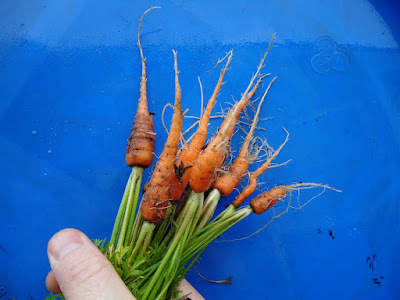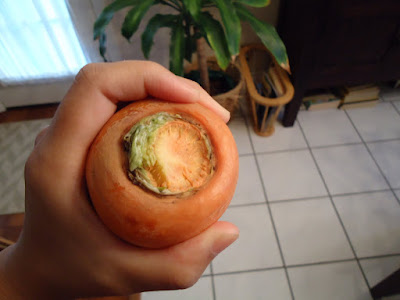Below is a list of fall vegetable seeds sown so far in our garden and their planting dates. I'm trying out successive planting with some of them. I would have sown them earlier, but it's just been so hot all of July and August, and I didn't think that these seeds would germinate all that well when day time highs have been consistently in the low to mid 90s. Our Indianapolis garden is in USDA zone 5b with the average first frost date of around October 20. I'm curious to see if this year's first frost would be later than this average date, considering how hot it's been so far.
- Crimson Giant Radish – 7/31/10 (probably sowed too early, as they are not growing very well)
- Ruby Queen Beets – 7/31/10 (same as radish, not growing well past initial germination)
- Sugar snap peas (aka butt peas) – 8/1/10
- Carrots (I still have dreams of growing girthy carrots in Indiana) – 8/8/10
- China Choi (seeds shared by Ottawa Gardener) – 8/16/10, 8/28/10
- Pak Choi Cabbage – 8/22/10, 8/28/10
- Tatsoi Cabbage (rosette bok choy) – 8/22/10, 8/28/10
- Ruby Red Chard – 8/22/10, 8/28/10
- Fordhook Giant Chard – 8/22/10, 8/28/10
- Red Russian Kale – 8/22/10, 8/28/10
- Little Gem Lettuce – 8/22/10, 8/28/10
- Ruby Lettuce – 8/22/10, 8/28/10
- Red Romaine Lettuce – 8/22/10, 8/28/10
- Daikon Radish – 8/22/10
If any of these fall vegetables grow well for us, then I’m going to have to find new recipes to work them into meals. I figure lettuce is lettuce regardless of the variety, and I can use them in salads. But what to do with all these new hardy greens like chard, kale, and various chinese cabbages? This fall is going to be an interesting time for us both in the garden and in the kitchen!
Below are some pictures of germinated seedlings. I noticed that all of the seeds sprouted more than one seedling. With very small seeds like Pak Choi, it's possible that I sowed more than one seed in the middle of the square, but with bigger seeds like chards, I know I only sowed one seed in each spot. Are some of these seeds supposed to germinate more than one seedling from a single seed? Should I thin these out so there's only one seeding growing in each spot, or should I just leave them alone? Can I try to separate out the seedlings and transplant them farther apart without damaging the roots? Hmm, questions and more questions...
Fordhook Giant Chard
Ruby Red Chard
Red Russian Kale
Pak Choi Cabbage



















































